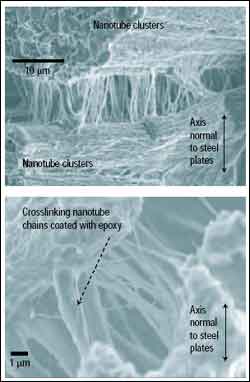Carbon Nanotube "Shock Absorbers" Excel At Dampening Vibration

This image shows clusters of the carbon-nanotube vibration-dampening material. Credit: Nikhil Koratkar, Rensselaer Polytechnic Institute. Image for media use only.
Researchers at Rensselaer Polytechnic Institute have developed a novel carbon-nanotube-based material that chokes vibration and may have applications for both large and small devices.
In the January 9, 2004, advance online edition of Nature Materials, the researchers describe the new material and demonstrate its usefulness as a filler to enhance traditional vibration-reduction materials.
Conducted by Nikhil Koratkar and colleagues at Rensselaer, the research arose from Koratkar’s National Science Foundation (NSF) Faculty Early Career Development (CAREER) Award, which recognizes outstanding scientists and engineers who, early in their careers, show exceptional potential for leadership at the frontiers of knowledge. This award is the highest honor bestowed by NSF on scientists and engineers beginning their independent careers.
Comments from NSF:
“True to the spirit of nanoscale engineering, Koratkar’s team developed unique composite materials to maximize frictional damping. Although one may argue that carbon nanotubes are too expensive to use in practical systems, there is no reason why other, less expensive, nanoscale materials cannot be incorporated to accomplish the same task. This is an excellent example of someone taking lemon and turning it into lemonade.” – Yip-Wah Chung, Director of the NSF Surface Engineering and Material Design Program
“In most mechanical systems, friction is often considered to be a negative attribute because it results in wear and unnecessary energy dissipation. In this case, professor Koratkar took advantage of friction between sliding interfaces to damp vibrations.” – Yip-Wah Chung
Media Contact
More Information:
http://www.nsf.govAll latest news from the category: Materials Sciences
Materials management deals with the research, development, manufacturing and processing of raw and industrial materials. Key aspects here are biological and medical issues, which play an increasingly important role in this field.
innovations-report offers in-depth articles related to the development and application of materials and the structure and properties of new materials.
Newest articles

Solving the riddle of the sphingolipids in coronary artery disease
Weill Cornell Medicine investigators have uncovered a way to unleash in blood vessels the protective effects of a type of fat-related molecule known as a sphingolipid, suggesting a promising new…

Rocks with the oldest evidence yet of Earth’s magnetic field
The 3.7 billion-year-old rocks may extend the magnetic field’s age by 200 million years. Geologists at MIT and Oxford University have uncovered ancient rocks in Greenland that bear the oldest…

Decisive breakthrough for battery production
Storing and utilising energy with innovative sulphur-based cathodes. HU research team develops foundations for sustainable battery technology Electric vehicles and portable electronic devices such as laptops and mobile phones are…





















